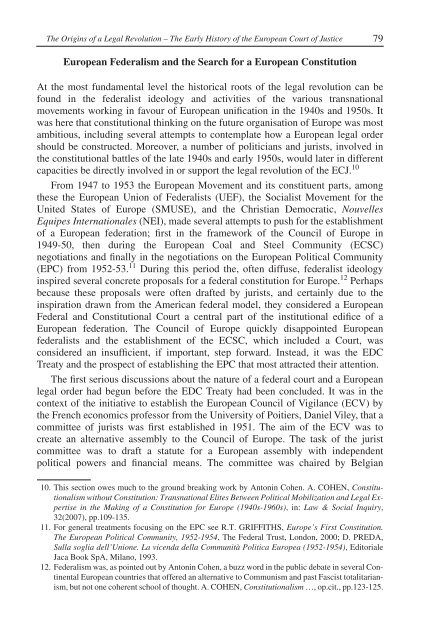2008, Volume 14, N°2 - Centre d'études et de recherches ...
2008, Volume 14, N°2 - Centre d'études et de recherches ...
2008, Volume 14, N°2 - Centre d'études et de recherches ...
You also want an ePaper? Increase the reach of your titles
YUMPU automatically turns print PDFs into web optimized ePapers that Google loves.
The Origins of a Legal Revolution – The Early History of the European Court of Justice 79<br />
European Fe<strong>de</strong>ralism and the Search for a European Constitution<br />
At the most fundamental level the historical roots of the legal revolution can be<br />
found in the fe<strong>de</strong>ralist i<strong>de</strong>ology and activities of the various transnational<br />
movements working in favour of European unification in the 1940s and 1950s. It<br />
was here that constitutional thinking on the future organisation of Europe was most<br />
ambitious, including several attempts to contemplate how a European legal or<strong>de</strong>r<br />
should be constructed. Moreover, a number of politicians and jurists, involved in<br />
the constitutional battles of the late 1940s and early 1950s, would later in different<br />
capacities be directly involved in or support the legal revolution of the ECJ. 10<br />
From 1947 to 1953 the European Movement and its constituent parts, among<br />
these the European Union of Fe<strong>de</strong>ralists (UEF), the Socialist Movement for the<br />
United States of Europe (SMUSE), and the Christian Democratic, Nouvelles<br />
Equipes Internationales (NEI), ma<strong>de</strong> several attempts to push for the establishment<br />
of a European fe<strong>de</strong>ration; first in the framework of the Council of Europe in<br />
1949-50, then during the European Coal and Steel Community (ECSC)<br />
negotiations and finally in the negotiations on the European Political Community<br />
(EPC) from 1952-53. 11 During this period the, often diffuse, fe<strong>de</strong>ralist i<strong>de</strong>ology<br />
inspired several concr<strong>et</strong>e proposals for a fe<strong>de</strong>ral constitution for Europe. 12 Perhaps<br />
because these proposals were often drafted by jurists, and certainly due to the<br />
inspiration drawn from the American fe<strong>de</strong>ral mo<strong>de</strong>l, they consi<strong>de</strong>red a European<br />
Fe<strong>de</strong>ral and Constitutional Court a central part of the institutional edifice of a<br />
European fe<strong>de</strong>ration. The Council of Europe quickly disappointed European<br />
fe<strong>de</strong>ralists and the establishment of the ECSC, which inclu<strong>de</strong>d a Court, was<br />
consi<strong>de</strong>red an insufficient, if important, step forward. Instead, it was the EDC<br />
Treaty and the prospect of establishing the EPC that most attracted their attention.<br />
The first serious discussions about the nature of a fe<strong>de</strong>ral court and a European<br />
legal or<strong>de</strong>r had begun before the EDC Treaty had been conclu<strong>de</strong>d. It was in the<br />
context of the initiative to establish the European Council of Vigilance (ECV) by<br />
the French economics professor from the University of Poitiers, Daniel Viley, that a<br />
committee of jurists was first established in 1951. The aim of the ECV was to<br />
create an alternative assembly to the Council of Europe. The task of the jurist<br />
committee was to draft a statute for a European assembly with in<strong>de</strong>pen<strong>de</strong>nt<br />
political powers and financial means. The committee was chaired by Belgian<br />
10. This section owes much to the ground breaking work by Antonin Cohen. A. COHEN, Constitutionalism<br />
without Constitution: Transnational Elites B<strong>et</strong>ween Political Mobilization and Legal Expertise<br />
in the Making of a Constitution for Europe (1940s-1960s), in: Law & Social Inquiry,<br />
32(2007), pp.109-135.<br />
11. For general treatments focusing on the EPC see R.T. GRIFFITHS, Europe’s First Constitution.<br />
The European Political Community, 1952-1954, The Fe<strong>de</strong>ral Trust, London, 2000; D. PREDA,<br />
Sulla soglia <strong>de</strong>ll’Unione. La vicenda <strong>de</strong>lla Communità Politica Europea (1952-1954), Editoriale<br />
Jaca Book SpA, Milano, 1993.<br />
12. Fe<strong>de</strong>ralism was, as pointed out by Antonin Cohen, a buzz word in the public <strong>de</strong>bate in several Continental<br />
European countries that offered an alternative to Communism and past Fascist totalitarianism,<br />
but not one coherent school of thought. A. COHEN, Constitutionalism …, op.cit., pp.123-125.

















